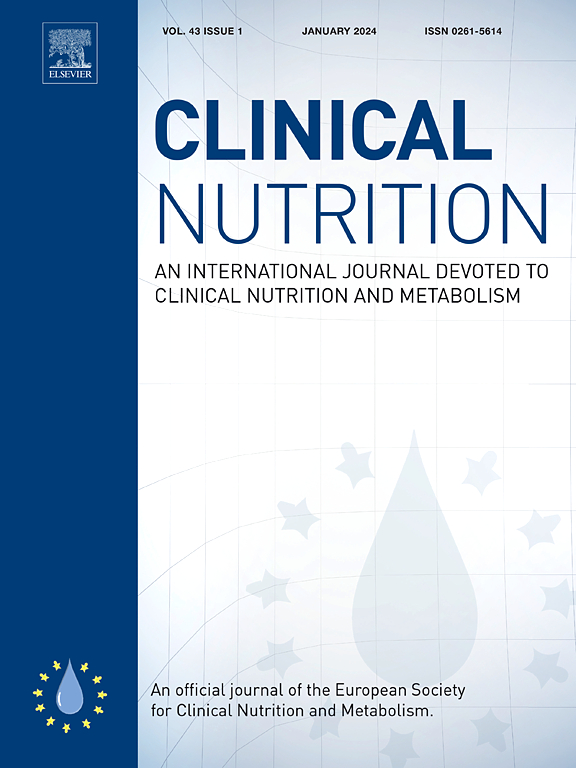心肺运动测试期间的脂肪氧化能力分析表明,"后科维德-19 "综合征患者的代谢紊乱会长期存在
IF 6.6
2区 医学
Q1 NUTRITION & DIETETICS
引用次数: 0
摘要
背景& 目的Post-COVID-19 综合征(PCS)以疲劳、体能下降、呼吸困难、认知障碍和心理困扰等症状为特征。PCS 的发病机制和严重程度表明,线粒体功能障碍是导致 PCS 的重要因素。本研究考察了运动过程中脂肪氧化作为线粒体能力功能的情况。方法在住院康复期间进行单中心前瞻性队列研究。入院和出院时进行心肺运动测试,并使用问卷进行疲劳评估。结果患者(N = 187;38 % 女性;49.7 ± 11.4 岁)在感染后 253.4 ± 130.6 天转入康复中心。主要症状包括疲劳/运动不耐受(79.9%)、气短(77.0%)和认知功能障碍(55.1%)。与健康对照组相比,PCS 患者的脂肪氧化能力总体上受到干扰(AUC:11.3 [10.7-11.9])(p < 0.0001),急性感染期间的住院治疗可预测干扰程度(p < 0.0001)。低运动能力和高疲劳评分导致脂肪氧化减少(均为 p <0.0001)。尤其是年轻男性的脂肪氧化能力明显下降(性别:p = 0.002;年龄:p < 0.001)。在以运动为基础的康复过程中,代谢紊乱得到了明显改善(AUC:14.9 [14.4-15.4];p <;0.0001),即使是年轻的受损男性群体(+44.2%;p <;0.0001)也是如此。结论 PCS 特异性脂肪氧化受限可能表明线粒体功能持续障碍。对 PCS 患者的临床评估应包括在运动过程中进行详细的逐次呼吸分析,以确定新陈代谢的改变,尤其是本报告中发现的年轻男性群体。运动康复可提高运动能力和脂肪氧化能力,从而改善线粒体功能。临床试验:NCT06468722。本文章由计算机程序翻译,如有差异,请以英文原文为准。
Analysis of fat oxidation capacity during cardiopulmonary exercise testing indicates long-lasting metabolic disturbance in patients with post-covid-19 syndrome
Background & aims
Post-COVID-19 Syndrome (PCS) is characterized by symptoms including fatigue, reduced physical performance, dyspnea, cognitive impairment, and psychological distress. The mechanisms underlying the onset and severity of PCS point to mitochondrial dysfunction as significant contributor. This study examined fat oxidation as a function of mitochondrial capacity during exercise.
Methods
Single-center prospective cohort study during inpatient rehabilitation. Cardiopulmonary exercise testing and assessment of fatigue using questionnaires were performed at admission and discharge. Detailed spirometric breath-by-breath data were used to calculate substrate oxidation rates.
Results
Patients (N = 187; 38 % women; 49.7 ± 11.4 years) were referred to rehabilitation 253.4 ± 130.6 days after infection. Lead symptoms included fatigue/exercise intolerance (79.9 %), shortness of breath (77.0 %), and cognitive dysfunction (55.1 %). Fat oxidation capacity was disturbed in PCS patients overall (AUC: 11.3 [10.7–11.9]) compared to healthy controls (p < 0.0001), with hospitalization during acute infection predicting the level of disturbance (p < 0.0001). Low exercise capacity and high fatigue scores resulted in reduced fat oxidation (both p < 0.0001). In particular, younger males were affected by significantly reduced fat oxidation capacity (sex: p = 0.002; age: p < 0.001). Metabolic disturbance was significantly improved during exercise-based rehabilitation (AUC: 14.9 [14.4–15.4]; p < 0.0001), even for the group of younger impaired males (+44.2 %; p < 0.0001). Carbohydrate oxidation was not impaired.
Conclusions
PCS-specific restrictions in fat oxidation may indicate persistent mitochondrial dysfunction. Clinical assessment of PCS patients should include detailed breath-by-breath analysis during exercise to identify metabolic alterations especially in the group of younger males identified in this report. Exercise-based rehabilitation results in improved exercise capacity and fat oxidation and thus likely mitochondrial function. Clinical Trials: NCT06468722.
求助全文
通过发布文献求助,成功后即可免费获取论文全文。
去求助
来源期刊

Clinical nutrition
医学-营养学
CiteScore
14.10
自引率
6.30%
发文量
356
审稿时长
28 days
期刊介绍:
Clinical Nutrition, the official journal of ESPEN, The European Society for Clinical Nutrition and Metabolism, is an international journal providing essential scientific information on nutritional and metabolic care and the relationship between nutrition and disease both in the setting of basic science and clinical practice. Published bi-monthly, each issue combines original articles and reviews providing an invaluable reference for any specialist concerned with these fields.
 求助内容:
求助内容: 应助结果提醒方式:
应助结果提醒方式:


